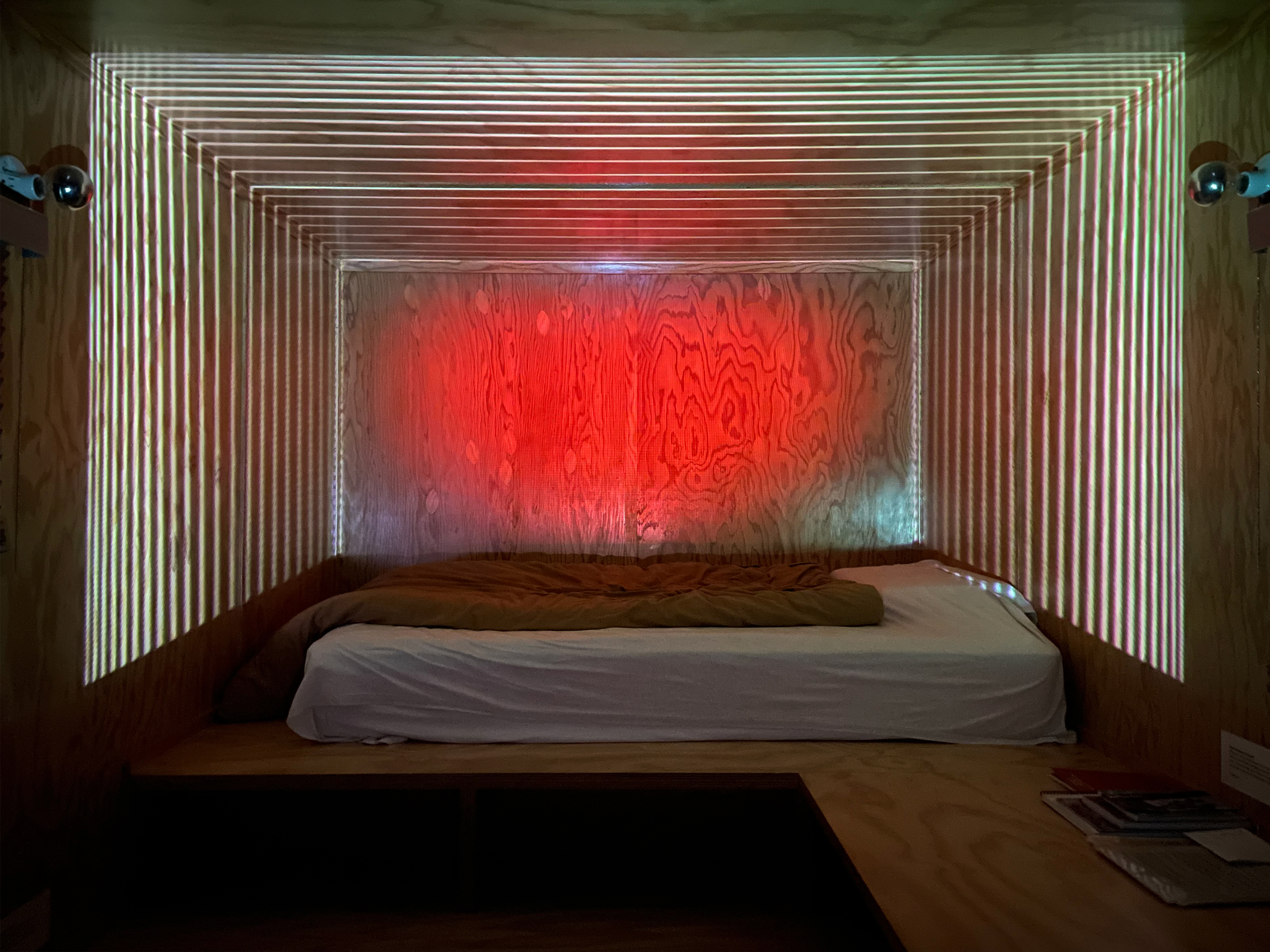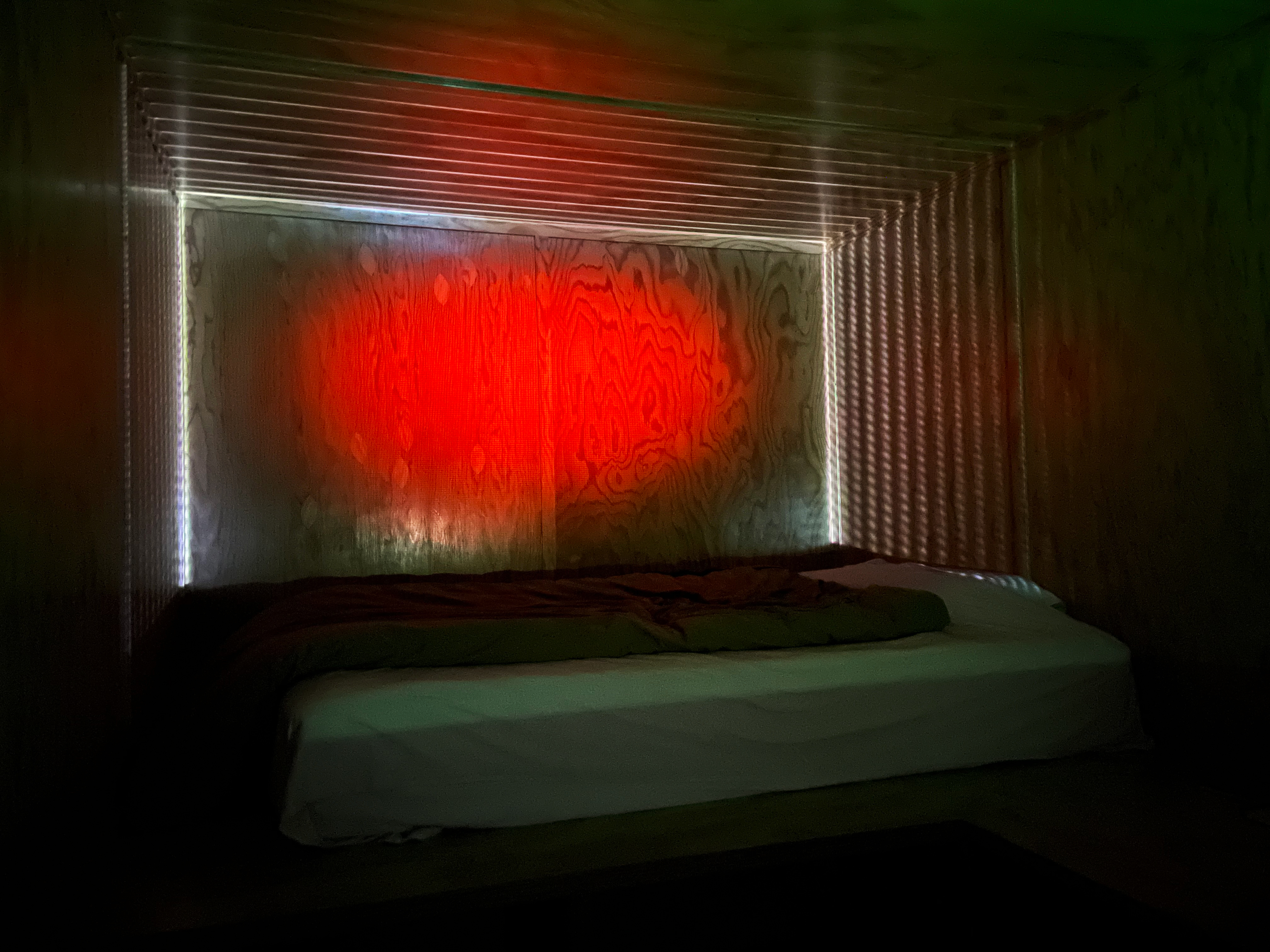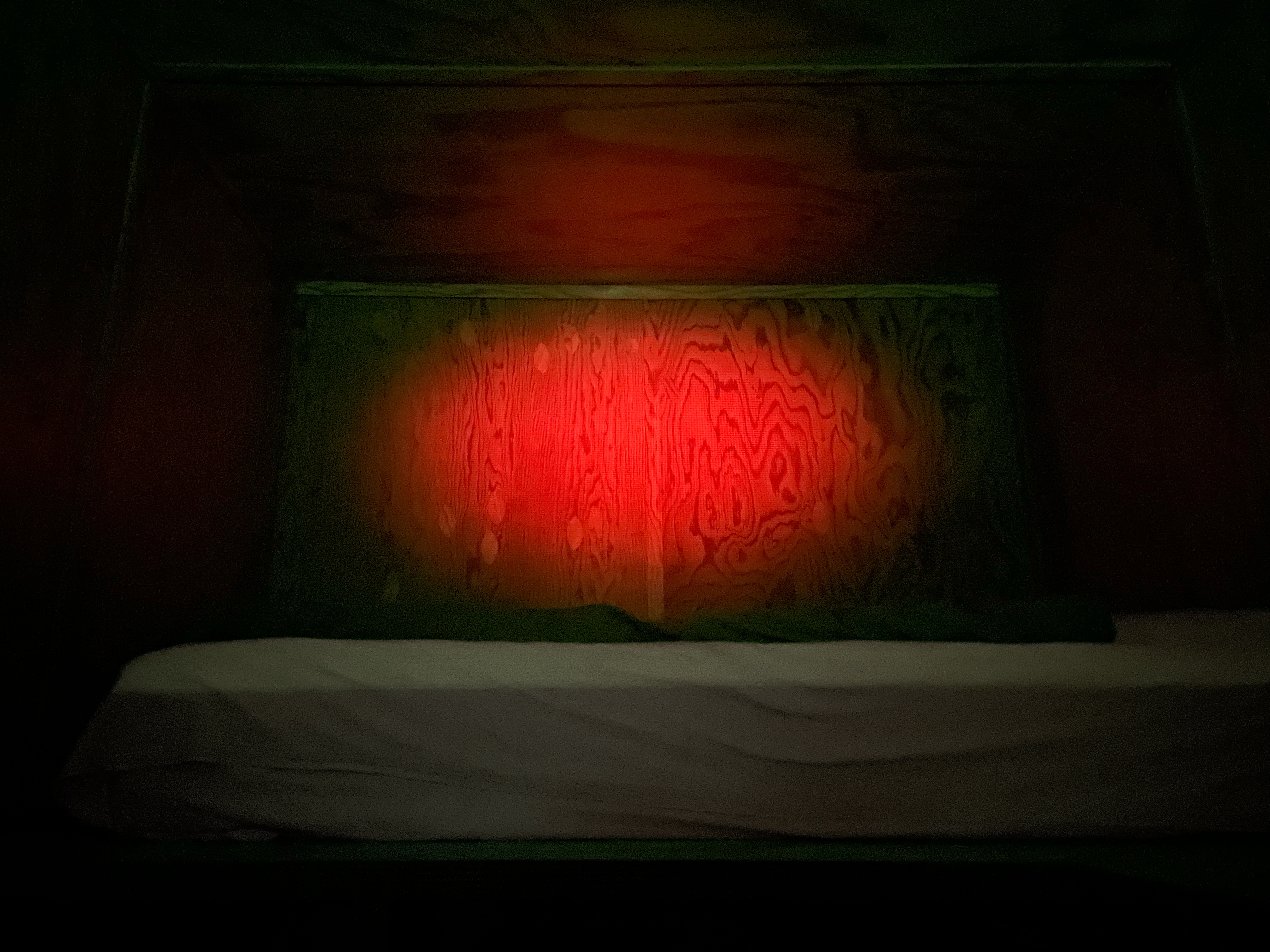CHANNEL
2023
Site-Specific Immersive Media Installation: Projection-Mapped Abstract Animation inside a Converted Shipping Container: Plywood, Mattress, Bedding, 92x92x92 inches, 7:00
This piece was made while in residence at High Desert Test Sites, part of AZ-West,
Joshua Tree, CA.
Site-Specific Immersive Media Installation: Projection-Mapped Abstract Animation inside a Converted Shipping Container: Plywood, Mattress, Bedding, 92x92x92 inches, 7:00
This piece was made while in residence at High Desert Test Sites, part of AZ-West,
Joshua Tree, CA.
Still Images:
click to enlarge






Channel was a site-specific immersive video experience. While completing a work trade residency at High Desert Test Sites, I lived in a shipping container that had been converted by Andrea Zittel into a living space, along with an outdoor kitchen, bathroom, and living room, on her property outside of Joshua Tree, CA. In typical Zittel style, it was minimal, thoughtful, and multifunctional: the desk became the bed platform, storage doubled as seating, and everything was made from plywood. I loved it.
In true Hadley style, I turned my projector on and started tracing the corners where the walls met the ceiling and each other. Single-pixel-width lines emerged as light from those corners, expanding out to surround me as I sat on the floor looking up. Once it was moving, I could bathe myself in it by climbing into my bed.
I was reading River of Shadows, Rebecca Solnit’s award-winning biography of Eadward Muybridge. Rather than a lesson in art history, it was a poetic exploration and scholarly analysis of the disembodiment of humanity’s relationship with time and space. This rupture, which came to define modernity, arrived with the proliferation of electricity, the railroad, and photography. Solnit described the advent of moving images as the merging of all three.
On this residency, my main goal was to be intentionally non-productive. I needed to be, instead of do. I read. A lot. When I got restless, I hiked. I worked for the residency and hung out with the staff and artists. I listened to the quails, watched the sunset, and looked at the stars. I cried and journaled and collected rocks, cans, and dried cacti. I avoided social media and told myself I didn’t have to make anything. Actually, I said I wasn’t allowed to make anything unless I really wanted to. The point was to let go of productivity anxiety. And, it worked.
[Please note: On this residency, I did not have access to a DSLR camera. All documentation was recorded on my mobile phone, which does a poor job of capturing such low-light video. I’m choosing to share the video because I’m proud of the work, if not the documentation.]
Refusing to push myself, I went to bed when I was tired, woke up when I was sufficiently rested, ate when I was hungry, and indulged all of my impulses and curiosities. Not surprisingly, an energy and enthusiasm for things like putting new curatorial proposals together (proposals always make me feel drained) took me over. I had more ideas flowing into my mind than I knew what to do with. I was making deep connections between my personal trauma healing journey, Rebecca Solnit’s thesis on time and place, the landscape and nature tourism to which I was a witness on that trip, and the deeper societal ruptures and cognitive dissonance that seem to be the hallmark of the last century-and-a-half.
Choosing to be rather than do was powerful. The work I ended up making challenged me to learn new coding and animation techniques. I thought that the straight lines would be too simple. But, the opposite was true: the lines were not perfectly straight on the computer screen and, as they climbed from one row of pixels to the next, each line became a wave. Indeed, the lines together appeared to ripple. As I animated, I had a strong impulse to bring a glowing redness to the center of the wall, the heart of the lines. Once it was there, I was struck by how much it reminded me of the first James Turrell piece I ever saw. I remember in my body what that work did to me. It upended my confidence in my ability to discern space, scale, and color. Yet, it wasn’t unnerving. It was calming. Expansive. So was this.
I invited the other residents and HDTS staff to experience it. They, too, sat on the floor and hopped into the bed. They told me all the things it made them feel and think about. How they resisted at first because the slowness was hard. But they adjusted and then did not want to leave. In much the same way, I’d resisted the non-productivity of embeddedness. But I adjusted. I became a desert person, and when it came time to leave, I didn’t want to go. Back home in Portland, I miss Joshua Tree. I miss waking up as the sun rises and making my coffee outside while the quails coo and scurry around with perhaps a coyote down the hill. I knew where I was, and it gave me a sense of purpose. I was existing only for that. It’s very hard to maintain that embodied relationship to time and place when I’m running from work to home to meetings, trying to remember to cook, and do laundry, and move my body, and play. It’s hard to be a person when you’re busy making other people rich, trying to be a good partner and friend and child and sibling, while thousands are slaughtered and criminals run for office, and Elon blows up space shuttles while houseless people dig through my dumpsters for returnables.
I’m thankful to have the luxury of struggling to remember what it’s like to live in my body, connected to the land, in time with the sun. I will keep striving to remember and to share my efforts so that others might also have access to things that feel like time and place.
Refusing to push myself, I went to bed when I was tired, woke up when I was sufficiently rested, ate when I was hungry, and indulged all of my impulses and curiosities. Not surprisingly, an energy and enthusiasm for things like putting new curatorial proposals together (proposals always make me feel drained) took me over. I had more ideas flowing into my mind than I knew what to do with. I was making deep connections between my personal trauma healing journey, Rebecca Solnit’s thesis on time and place, the landscape and nature tourism to which I was a witness on that trip, and the deeper societal ruptures and cognitive dissonance that seem to be the hallmark of the last century-and-a-half.
Choosing to be rather than do was powerful. The work I ended up making challenged me to learn new coding and animation techniques. I thought that the straight lines would be too simple. But, the opposite was true: the lines were not perfectly straight on the computer screen and, as they climbed from one row of pixels to the next, each line became a wave. Indeed, the lines together appeared to ripple. As I animated, I had a strong impulse to bring a glowing redness to the center of the wall, the heart of the lines. Once it was there, I was struck by how much it reminded me of the first James Turrell piece I ever saw. I remember in my body what that work did to me. It upended my confidence in my ability to discern space, scale, and color. Yet, it wasn’t unnerving. It was calming. Expansive. So was this.
I invited the other residents and HDTS staff to experience it. They, too, sat on the floor and hopped into the bed. They told me all the things it made them feel and think about. How they resisted at first because the slowness was hard. But they adjusted and then did not want to leave. In much the same way, I’d resisted the non-productivity of embeddedness. But I adjusted. I became a desert person, and when it came time to leave, I didn’t want to go. Back home in Portland, I miss Joshua Tree. I miss waking up as the sun rises and making my coffee outside while the quails coo and scurry around with perhaps a coyote down the hill. I knew where I was, and it gave me a sense of purpose. I was existing only for that. It’s very hard to maintain that embodied relationship to time and place when I’m running from work to home to meetings, trying to remember to cook, and do laundry, and move my body, and play. It’s hard to be a person when you’re busy making other people rich, trying to be a good partner and friend and child and sibling, while thousands are slaughtered and criminals run for office, and Elon blows up space shuttles while houseless people dig through my dumpsters for returnables.
I’m thankful to have the luxury of struggling to remember what it’s like to live in my body, connected to the land, in time with the sun. I will keep striving to remember and to share my efforts so that others might also have access to things that feel like time and place.